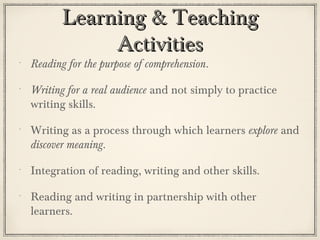Whole Language Approach
- 1. Whole-language Approach Presented By: Sergio Meza Padilla, M.Ed. Bilingual Coordinator Cartagena International School - 2014
- 2. “Education is the most powerful weapon which you can use to change the world.” –Nelson Mandela
- 3. Introduction Whole Language was created in the 1980s by a group of U.S educators concerned with the teaching of language arts, that is, reading and writing in the native language (L1). The teaching of reading and writing in the L1 (also called the teaching of literacy) is a very active educational enterprise worldwide that has led to a number of different approaches and methodologies. One of these approaches focuses on decoding, which is the teaching of language components separately (grammar, vocabulary, word cognition, & phonics).
- 4. Introduction Whole Language argues that language should be taught as a “whole.” Whole Language instruction is a theory of language instruction developed to help young children learn to read, and to the teaching of ESL (English as a Second Language). Whole Language approach emphasizes learning to read and write naturally with a focus on real communication and reading and writing for pleasure. In the 1990s, Whole Language became popular in the US as a motivating and innovative way of teaching language arts to primary school children.
- 5. Introduction In language teaching, Whole Language shares a philosophical and instructional perspective with Communicative Language Teaching (CLT) since it emphasizes on the importance of meaning and meaning making in teaching and learning. Whole Language also relates to natural approaches to language learning since it is designed to help children and adults learn an L2 in the same way children learn their L1 (esp. in ESL case scenarios).
- 6. Theory Of Language Whole Language views language from an interactional perspective. In this perspective, language functions as a vehicle for human communication. Heavy emphasis on is placed on “authenticity,” on conversation. For example: in mastering the sociolinguistic signals for apologizing, a Whole Language perspective requires an authentic situation in which one truly needs to apologize (esp. in ESL classes).
- 7. Theory Of Language Whole Language also views language as a vehicle for internal “interaction,” for egocentric speech, for thinking. We also use language to think (Rigg, 1991). A Functional model of language is also referred to in Whole Language because language is seen as something that is used for meaningful purposes and to carry out authentic functions (esp. for ESL Adult classes).
- 8. Theory Of Learning The learning theory underlying Whole Language is in the humanistic and constructivist schools. Whole Language is said to be authentic, personalized, selfdirected, collaborative, and pluralistic. Such characteristics are to focus learner attention and to motivate mastery. Constructivist learning theory hold that knowledge is constructed, rather than received or discovered. Constructivist learners create meaning, learn by doing, and work collaboratively in mixed groups on common projects.
- 9. Objectives in Whole Language Integration of reading, writing, and other skills (listening and speaking). The use of authentic literature rather than “artificial.” A focus on real and natural events rather than on specially designed written stories which do not relate to the students’ experience. Reading is conducted for the purpose of comprehension. Use of student-produced texts rather than teachergenerated or other-generated texts (esp. in ESL classes).
- 10. Syllabus Whole Language instruction advocates the use of realworld materials rather than commercial texts. Students are selectors of learning materials. Choice is vital in a whole language class, because without the ability to select activities, materials, and conversational partners, the Ss cannot use language for their own purpose. Schools make use of class sets of literature, both fictional and nonfictional.
- 11. Learning & Teaching Activities Reading for the purpose of comprehension. Writing for a real audience and not simply to practice writing skills. Writing as a process through which learners explore and discover meaning. Integration of reading, writing and other skills. Reading and writing in partnership with other learners.
- 12. Learner & Teacher Roles The teacher is seen as a facilitator. The teacher is an active participant in the learning community, and not an expert passing on knowledge to the Ss. The teacher teaches Ss, and not the subject matter. The teachers creates a climate that enables collaborative learning. The learner collaborates with his classmates, and with the teacher (pair work and whole group activities). Students are evaluators of their learning process with the help of the teacher. The learner is self-directed, his experiences are used as resources to enrich the learning process.
- 13. Procedures The use of literature. The use of process writing (pre-writing, drafting, revising, editing, publishing). Encouragement of cooperative learning among Ss (pair work and whole group activities). Concern for Ss’ attitude. Individual and small group reading and writing. Ungraded (with no grade in class) dialogue journals. Writing portfolios. Student-made books. Story writing.
- 14. Conclusions The Whole Language movement is not a teaching method but an approach to learning that sees language as a whole entity. Each language teacher is free to implement the approach according to the needs of particular Ss and classes. Advantages claimed for Whole Language are as follows: focuses on experiences and activities that are relevant to Ss’ lives and needs, use of authentic materials, it can be used to facilitate the development of all aspects of an L2. Whole Language promotes fluency at the expense of accuracy.
- 15. Bibliography Richards, J. & Rodgers, T. (2010). Approaches and Methods in Language Teaching. Cambridge: Cambridge University Press.
- 16. Questions?
- 17. Whole-language Approach Sergio Meza Padilla, M.Ed. Bilingual Coordinator Cartagena International School - 2014

















